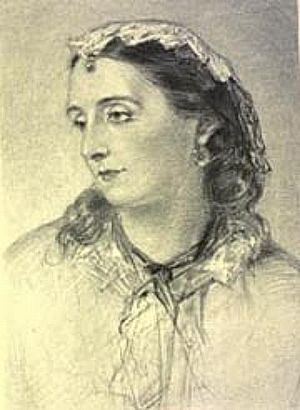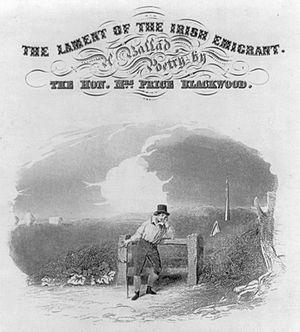Helen Blackwood, Baroness Dufferin and Claneboye facts for kids
Helen Selina Blackwood (born Helen Sheridan on January 18, 1807) was a talented Irish writer, songwriter, and composer. She was also known as Baroness Dufferin and Claneboye, and later Countess of Gifford. Helen was famous in London in the mid-1800s for her cleverness and writing skills. She passed away on June 13, 1867.
Contents
Early Life and Family Connections
Helen Sheridan came from a very creative family. Her father, Thomas Sheridan, was an actor and soldier. He was also the son of the famous Irish playwright Richard Brinsley Sheridan. Helen's mother, Caroline Henrietta Sheridan, was a novelist.
In 1813, when Helen was young, her family moved to the Cape of Good Hope (in South Africa) because of her father's job. Sadly, her father died there four years later in 1817. Helen then returned to England with her mother and siblings. They lived in a special apartment at Hampton Court Palace.
Helen had two younger sisters, Caroline and Georgiana. All three sisters were known for being beautiful and talented. People even called them the "Three Graces". Caroline became a very skilled writer, and Georgiana married into a noble family, becoming the Duchess of Somerset.
Marriages and Family Life
When Helen was seventeen, she got engaged to Commander Price Blackwood. His family was important, but they didn't want him to marry Helen because they thought she wasn't rich enough. Despite this, they got married in London on July 4, 1825.
After their wedding, Helen and Price lived in Florence, Italy, for two years. They returned to England with their baby son, Frederick, who was born in 1826. Helen's sisters helped her meet many important people in London society, including writers and politicians like Benjamin Disraeli. Disraeli later said she was "his chief admiration."
In 1839, Helen became Lady Dufferin when her husband inherited his family's title. Sadly, he died in 1841. Helen continued to spend her summers at his family estate, Clandeboye in Ireland, which now belonged to her son Frederick.
In 1862, Helen married her friend George Hay, Earl of Gifford. He was seriously hurt in an accident, and they married shortly before he passed away from his injuries two months later.
Helen's Creative Writing
From a young age, Helen loved to write poems, songs, and short plays for family shows. She and her sister Caroline even published a collection of ten songs and two duets together. Helen then started to publish her own poems, sometimes adding her own music to them.
One of her most famous songs was The Irish Emigrant. This song was published in London, New York, and Boston. It showed her understanding of the struggles faced by Irish people, especially during the Great Irish Famine in the mid-1800s. Even though she was from a different social class, her songs showed deep sympathy for her neighbors. One writer, Alfred Perceval Graves, said her "warm heart beats in such close sympathy with her peasant neighbours."
In 1863, one of Helen's plays, Finesse, or, A Busy Day in Messina, was performed at the Haymarket Theatre. It was a success, but Helen didn't go to any of the shows and didn't tell people she was the author.
That same year, she published a funny book about her travels up the Nile River with her son. The book was called Lispings from Low Latitudes, or, Extracts from the Journal of the Hon. Impulsia Gushington. It made fun of how some women wrote about their travels. Her son Frederick had also written a travel book called Letters From High Latitudes, and her book was a playful response to his.
Helen's poems and songs often talked about important issues of her time. She wrote about social classes, poverty in Ireland, and the sadness of loss and separation. While her early and later writings were often witty, her songs and poems from the middle of her life were often very emotional and sad.
Later Life and Legacy
Helen Selina Blackwood died from breast cancer on June 13, 1867. She was buried with her second husband.
Her son Frederick, who was very close to his mother, published a book of her Songs, Poems, & Verses in 1894, which included a story about her life. He also honored her in other ways. He named a village and a railway station on his land Helen's Bay. He also built Helen's Tower on the Clandeboye Estate in her memory. This tower even inspired poems by famous writers like Tennyson and Robert Browning. They compared Helen favorably to the legendary Helen of Troy, saying her face brought joy to everyone who saw it.
Poems online
- Lament of the Irish Emigrant



